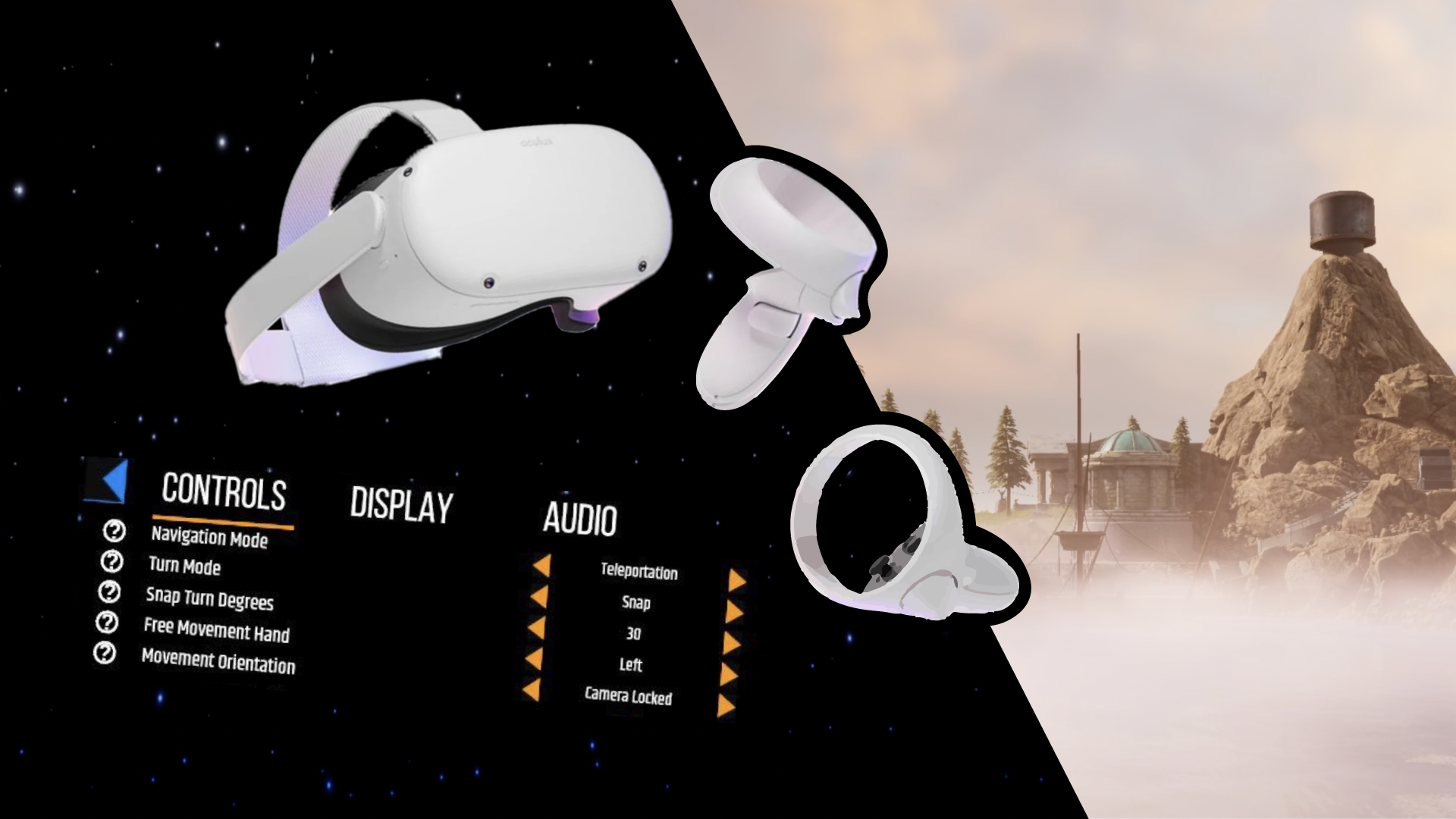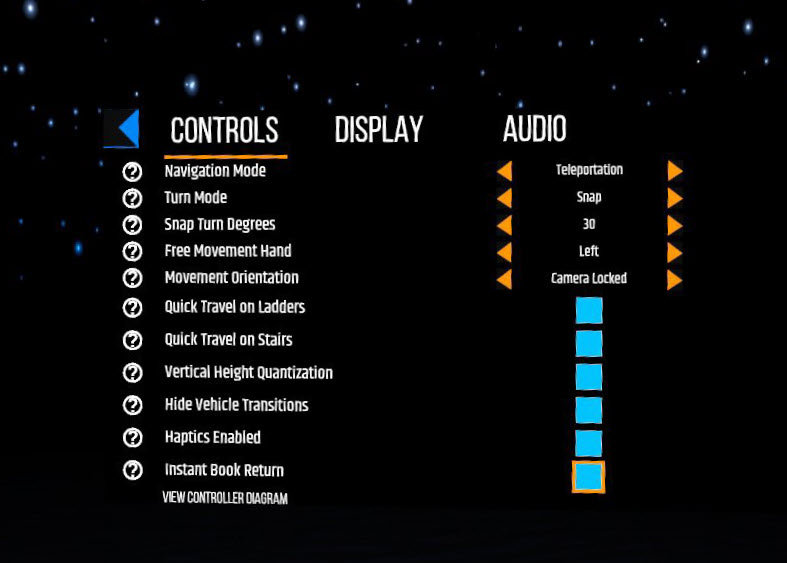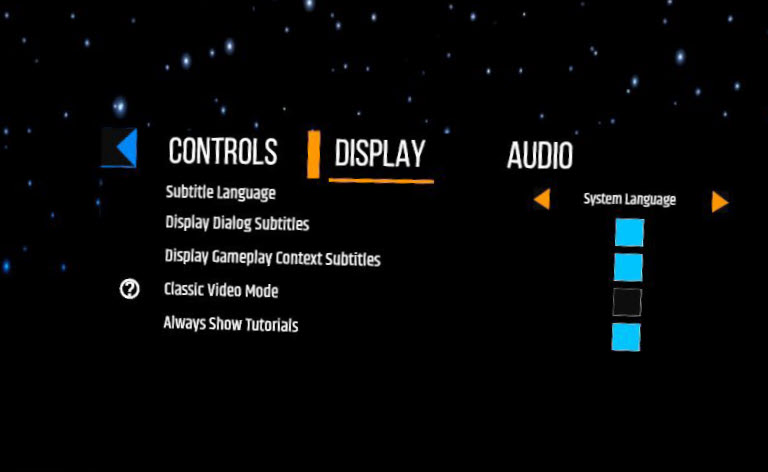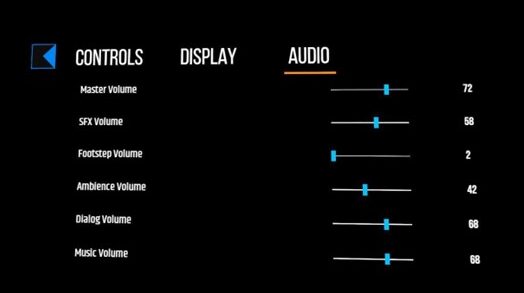Summary

There’s no such thing as 100% accessibility. There will always be at least one person who prefers something different from the majority. If there’s one thing video games are known for regardless of the platform, it’s providing gameplay options.
The options go beyond accessibility. Game developers want to let players customize their settings to ensure they have the best gaming experiences. When it comes to virtual reality, providing options can be a tricky proposition. This is because virtual reality has a unique vocabulary that not everyone knows or understands.
While my youngest was home from college, I downloaded a few virtual reality games for the Quest. One of them was Cyan’s Myst. It’s a famous game that’s been around since the 1990s. In the game, players travel to a mysterious island called Myst.
Players solve to travel to other locations called “Ages” where they unravel the mystery. They discover a story of family betrayal where they must make choices that affect the world of Myst and themselves. Myst has been remade for many platforms including virtual reality.
My son, of course, finished the game in less than a week. For me, it’s been a bumpy ride.
My First Experience in Myst Virtual Reality
My first foray into Myst virtual reality did not agree with me because it caused virtual reality motion sickness. Trying to find the best setting to limit motion sickness isn’t easy. I’d change one setting, and go back in the game to see what’s different. Then, I’d return to the settings. But it wasn’t always obvious what the setting does.
After opening the options, I changed the Navigation Mode from Smooth Movement to Teleportation. The difference between these two settings is amazing because it means the difference between experiencing motion sickness and not experiencing it.
Smooth Movement is watching the scene move in real-time as you travel from point A to point B. Unfortunately, this type of movement often causes motion sickness.
Teleportation takes you from point A to point B in an instant. It’s the virtual reality version of Star Trek’s beaming up. You jump from one spot to another spot. The less movement you see in virtual reality, the less likely you’ll experience motion sickness.
Turn Mode is like Navigation Mode. The options are Smooth and Snap. With Smooth, the player will see the scene move as they turn. Snap works like Teleportation in that you face a new direction (turning right or left) by the number of degrees you set. It reduces motion sickness.
I wasn’t sure which degree of snap turn would be the best one for someone who wants to minimize motion. With 60 degrees, it will take six turns to do a complete 360. While it cuts down the number of turns to do a complete circle, it can risk missing something in between. Hence, I settled on 45.
Free Movement Hand took some work to figure out. The free-movement hand is the hand that will do sideways movements (strafing). Even though I’m left-handed, I learned to use controllers based on the default. The right hand is usually the dominant in managing movement and the left hand is the helper. For this option, I kept the default.
Movement Orientation indicates how you move around the game. Motion controller locked changes the camera view based on controller movement. For example, when you nudge the thumb stick, it can turn around or go forward. Camera locked, which is the default, changes the view based on where the player looks.
Unlocked means head movement would not change based on the camera’s view. This is a valuable option as some people may have involuntary movements. They may want to unlock the camera so their involuntary head or body movements don’t accidentally move their character in the game.
However, when I tested out the different movement orientation options, I couldn’t tell the difference. So, I’d change a setting, go back into the game, and play it. Once I confirmed no difference, I’d return to the settings and tweak it again. This back-and-forth was tedious and caused motion sickness to the point that I had to stop.
It took quite a bit of time for me to experience whether I liked the specific setting. That’s because it takes a lot of time to go to settings, change something, and reload the main experience. One way I’ve seen some apps do with settings is to show a quick demonstration of what the setting does.
Quick Travel on Ladders and Stairs as well as Hide Vehicle Transitions are like Navigation Mode. Does the player want to see the animation of the movement or teleport? I’m not sure why the game would have three separate options. Why would someone want to Quick Travel on Ladder, but not on Stairs? The same goes for Vehicle Transitions. Are these overkill? Would it make sense that these fall under Navigation Mode?
Vertical Height Quantization reflects the scenes based on your height. When it’s turned on, the distance from your eyes to the ground in the game will match the distance in the real world. This game has a bug as whenever I tried to exit the underground area, I’d end up with the ground around my body instead of underneath my feet. This caused motion sickness because the brain could not make sense of it.
As for Instant Book Return, I’m not sure of its value. Perhaps, it’s less motion because you do not have to reach the ground to pick them up. However, accessing it in the original location may or may not have as much motion as picking it up from the ground.
Myst Control Settings
I learned just how complicated it can be while playing the virtual reality version of Myst on Meta Quest 2 as the next image shows the many available options for controls.
What I liked about Myst’s options is that there’s a [?] icon next to each one. Selecting the icon opens a description of the option.

Here’s a list of the controls, the options for each, and Myst’s description.
| Control | Options | Description |
| Navigation Mode | Smooth Movement and Teleportation | Teleport allows you to “teleport” to places by pushing forward on either thumb stick and releasing once your teleport node is in a designer location. Smooth movement allows you to smoothly move around as if you are walking around. We recommend enabling Teleport mode for a more comfortable experience. |
| Turn Mode | Smooth or Snap | Snap turning will “snap” you instantly to the number of degrees indicated below. Smooth turning will smoothly turn you for the duration you hold the non-free movement hand thumb stick. We recommend snap turn for a more comfortable gameplay experience. |
| Snap Turn Degrees | 7.5, 15, 30, 45, 60 | The number of degrees you will instantly turn about when Snap Turn is the selected turn mode. |
| Free Movement Hand | Left or right | This is the hand that will control strafing movement when using smooth movement. The left hand is the dominant free movement hand by default in most VR experiences. |
| Movement Orientation | Motion controller locked, unlocked, or camera locked | This sets what your movement direction in free roam navigation will be locked to in VR. By default, it is locked to your camera’s orientation. The option to lock your motion controller’s orientation will use the orientation of the hand selected for free movement. |
| Quick Travel on Ladders | On or off | If enabled, you will instantly appear at the top or bottom of a ladder once you grab the ladder. If disabled, you will have to manually climb each ladder you encounter. |
| Quick Travel on Stairs | On or off | If enabled, you will instantly appear at the top or bottom of stairs with many steps. Note that the travel nodes will only appear if in Teleportation navigation mode. |
| Vertical Height Quantization | On or off | If enabled, your height is automatically adjusted for a better real-life free-roam movement experience. We recommend keeping this option enabled for most experiences. |
| Hide Vehicle Transitions | On or off | If enabled, vehicle rides (like elevators) do not show their animations while you ride them. We recommend enabling this if you are sensitive to being moved. |
| Haptics Enabled | On or off | If enabled, controller vibrations will occur during specific gameplay interactions. |
| Instant Book Return | On or off | If enabled, readable books that are dropped will instantly return to their original location. |
| View Controller Diagram | Not applicable | Displays an image of the controller with labels showing what each button does. |
Myst Display Settings
Display settings refer to language, video, and tutorials. Only Classic Video Mode has a [?] icon next to it with a description. The rest are self-explanatory except for Display Gameplay Context Subtitles. That one isn’t clear. If it refers to game sounds that affect gameplay, then Display Gameplay Subtitles for Sounds would be clearer.

Here’s a list of the display controls, the options for each, and Myst’s description.
| Display | Options | Description |
| Subtitle Language | English, Chinese (China), French (France), German, Italian, Japanese, Korean, Polish, Portuguese (Brazil), Russian, Spanish (Mexico) | Changes language of text and dialog. |
| Display Dialog Subtitles | On or off | Display captions for spoken text. |
| Display Gameplay Context Subtitles | On or off | Display captions for sounds and other audio that’s not spoken. |
| Classic Video Mode | On or off | Enabling this replaces all updated character videos with the classic FMV-style videos from the original Myst. If you enable this option during a game session, you may need to re-load a save or restart the game in order to properly see the video changes occur. (FMV: full-motion video) |
| Always Show Tutorials | On or off | As you work through the game, it’ll show tutorials whenever you encounter something for the first time that has a tutorial. |
Myst Audio Settings
The audio settings give players a lot of control over the different types of sounds. These use sliders. The problem with sliders is that some people struggle with fine motor control. Volume controls include master, sound effects (SFX), footstep, ambiance, dialog, and music.

Recommendations for Virtual Reality App Developers and Designers
While not all the descriptions made sense, Myst is ahead of other gaming and app companies because many of them don’t provide an explanation of their options.
The Equal Entry team and I believe designers and developers to include a description of their options. The explanations of what each option does should be in plain language.
I still have a long way to go in making progress with Myst virtual reality. Since Myst was not originally designed for virtual reality, it’s been hard to play it for more than a few minutes as motion sickness kicks in.
One thing that would be useful in 3D and virtual reality apps and gaming is to have a single setting for reducing motion. Then, the user would not have to figure out which setting will help minimize motion sickness.
Do you need an accessibility audit or VPAT compliance documentation?
Equal Entry has a streamlined process that involves technical and manual checks to help you identify the accessibility issues that have the biggest impact on your users. Our approach is a manageable way for you to address these issues quickly.
Our team is up to date on the latest technology for websites, mobile apps, and trends such as AI and VR. In addition, we can provide compliance documentation such as VPAT accessibility conformance reports. These documents are typically required for procurement and are a great way to showcase your conformance.
Contact us to learn more about how we can be your accessibility partner.